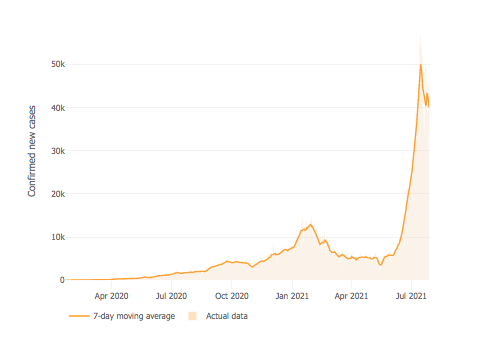The Delta wave has been a monster in Indonesia, but seems to have just started receding under a semi-lockdown.
By Robert Hurst, Athena Global Advisors, with help from the BIDUK Indonesia team.
July 29, 2021 — Dewy Pratama*, living and working in Jakarta, has accumulated quite a bit of knowledge about COVID from firsthand experience. Unwanted knowledge. She and her entire family caught COVID during the first wave and were quarantined for weeks in a hospital. A few weeks ago, her first cousin died with the Delta variant; she was just 43, and leaves behind young children.
At around the same time that her cousin died, the pastor at her church died of COVID in a Jakarta hospital. The hospitals had beds available but had run out of medical oxygen. Pratama recalled searching the city’s private dealers for oxygen to help the pastor, and finding none. She was just one of many engaged in the same desperate search.
The country was in a state of emergency in early July, first facing a bed shortage, then an oxygen shortage as the Delta variant exploded. The oxygen crisis around Jakarta has since been mitigated by imports from other countries, but remains a problem in different places around the country, like Bali.
Currently, during the last week of July, Indonesia (pop. 276M) is reporting approximately 40,000 new cases per day. Though the trend seems to have turned downward in recent days (see chart above, from Johns Hopkins University), the virus continues to ravage the country. Case and death counts are still far higher than they were during the emergency shortages that were occurring a few weeks ago. On Sunday July 25, 2021 there were 1,266 COVID fatalities.
In the USA (pop. 330M), the 7-day moving average of new cases is now over 60,000 per day, after more than 118,000 new cases were reported on Tuesday, July 27. But in the US deaths are currently on the order of a few hundred per day. This is a huge drop from the daily highs of about 2,000 deaths per day during the first wave, and 3,000 per day at the peak of the second. Indicators point ominously toward an impending Delta spike, but it’s too early to know where the US — with about half the country heavily resistant to any anti-virus measures — will go from here.
There are vast differences between the two countries in terms of vaccinations. An estimated 7% of Indonesians are fully vaccinated — about half the worldwide rate, and far below the US rate of 57%. While doses go unused in the United States, sitting in refrigerators with their expiration dates approaching, Indonesians who want to get vaccinated have to search for information and doses, as vaccine availability has been limited. Indonesians, even children, receive Sinovac or Aztrazeneca.
Strikingly, the US has already suffered over 610,000 COVID deaths, while Indonesia, with a population in the same ballpark, reports around 90,000 deaths. Even if we take into account that Indonesia’s numbers are likely undercounted severely (and assume the US number is somehow exact), by the most extreme estimates of undercounting (about 4x, according to some) the USA would still have far more COVID deaths so far.
In one country vaccine doses are hard to come by and in another they sit unused on the shelves, awaiting their expiration dates
The US government response (more accurately described as responses, with state and local governments all weighing in along with the feds) has been debated at length in the US, but what seems indisputable is that the Indonesian response has been a lot stronger, or authoritarian, or pick your own adjective preloaded to propagandize your readers whichever way you like and insert it here.
While Americans take the gold medal in complaining about government responses to COVID, the Indonesian restrictions make the American version look tame. Indonesian businesses are required to have all their employees work from home, a restriction enforced with door-to-door patrols and checkpoints. Restaurants are restricted and retail was all but shut down during the recent spike, although the government has declined to impose a full lockdown and restrictions are easing quickly as the situation begins to improve.
Indonesia is allowing foreign visitors into the country if they are fully vaccinated and test negative for COVID, but they will be required to isolate for 8 days anyway.[BBC] Under a testing regime focused on close contacts of infected patients, positives will be, in the words of a Bloomberg reporter, “immediately taken to isolation sites provided by the government.” Sounds quite draconian in those terms. However, there’s another way of saying that. BIDUK Program Officer Reyhan Fachry puts it like this: “The government provides free health facilities if you get COVID…free meals and medicines, free hospital charge, and even, if someone died because of COVID, the government will take care of the burials and will give the family some condolences money.” And the government is providing cash payments regardless of COVID status, essentially paying people to stay home.
Despite the vast differences in policy, Indonesian authorities face many of the same obstacles faced by the American authorities. Both countries have large numbers of citizens who are skeptical about the pandemic and who insist they won’t get vaccinated. According to Fachry, there is a sizable contingent in Indonesia who believe the vaccine is part of a scheme to turn people into 5G towers or insert microchips into their bodies, which sounds very familiar.
*Name changed to protect privacy.




0 Comments